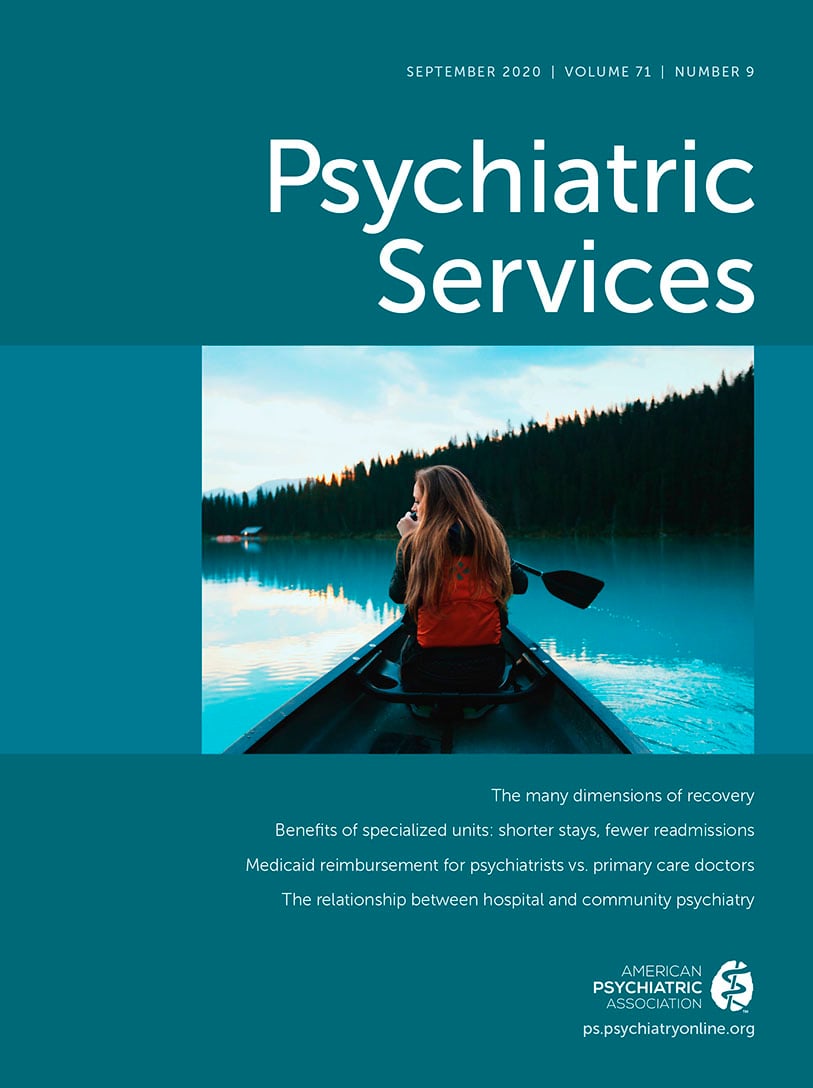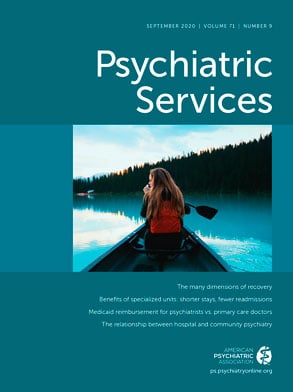More than 2 years have elapsed since the #MeToo movement first drew our nation’s attention to the long-neglected but rampant issue of sexual violence within U.S. culture. In its aftermath, many victims bravely stepped forward to publicly share their trauma, and corrective interventions were implemented to improve sexual safety in a variety of societal settings. However, despite this progress, keeping patients and staff safe from sexual violence remains a challenge for our nation’s psychiatric facilities.
Sexual violence within psychiatric facilities has been a concern since the era of asylums. Although a majority of such violence is patient-on-patient, staff members and visitors can also be victims or perpetrators (
1,
2). Despite the problem’s persistence, it is rarely on the agenda at psychiatric professional meetings or addressed in residency programs. The limited scholarship on inpatient sexual violence and its late entry into the psychiatric literature also speak to our field’s reluctance to engage with the subject.
The topic of sexual violence against psychiatric inpatients did not appear in the literature until 1976, when the article “Rape Accusations in Psychiatric Hospitals: Institutional Dynamics in Crisis” (
3) was published. Its authors began their work by stating, “It is surprising that, at least to the best of our knowledge, the topic of rape of hospitalized psychiatric patients has not been reported in the professional literature.” They went on to describe two alleged rapes of patients by staff members and discussed institutional approaches for handling such allegations. Concluding the paper, the authors noted, “Social pressures and professional ethics demand that we no longer avoid an open discussion of this subject within our academic forums.” Almost 45 years later, living up to this earnest suggestion remains a struggle for psychiatry.
In recent years, patient safety efforts in U.S. psychiatric facilities have largely focused on minimizing restraints and preventing suicide, which is rare, occurring at a rate of three per 100,000 inpatient psychiatric admissions and leading to 31–52 deaths annually (
4). Far less attention has been paid to sexual violence in this setting, which, as discussed below, happens much more frequently. In contrast, regulators in the United Kingdom have focused on the issue more. In 2018, the United Kingdom Care Quality Commission published a study (
2) revealing that 273 alleged sexual assaults in psychiatric facilities were reported to the National Health Service during a 3-month period. To more effectively prevent sexual violence, the report recommended “clearer guidance to staff, training so that staff can better support the sexual wellbeing of patients, strengthening of the [hospital sexual misconduct] reporting system, and investment in the physical and therapeutic environment of wards.”
Limited investigation into this topic by U.S. researchers has produced only a handful of small, dated studies that can help estimate the prevalence of sexual violence against psychiatric inpatients in our country. However, the evidence is compelling and suggests the problem is more pervasive than most would expect. In a 2005 study (
1), 8% of patients reported being forced into sexual contact by another patient while psychiatrically hospitalized, and 3% reported sexual coercion by a staff member. In a 2012 national survey of state psychiatric hospital directors, participants estimated that within the previous year, 7% of patients had been victims of major sexual misconduct (
5).
One of the most important factors contributing to sexual assaults in psychiatric facilities is severe mental illness experienced by inpatients. Conditions like mania, psychosis, and dementia often cause reduced awareness, impaired judgment, and hypersexuality. Patients with these conditions may be exploited by others or become perpetrators themselves. One UK study revealed that more than 13% of psychiatric inpatients engaged in some type of sexual behavior during the first 2 weeks of their stay, with indecent exposure and nonconsensual sexual touching being most common (
6). Appropriate management of patients with these serious conditions requires high staff-to-patient ratios and intensive supervision.
Another contributory factor is that individuals with antisocial personality disorder are psychiatrically hospitalized regularly, due to either malingering or the legitimate need for treatment of comorbid conditions. Once admitted, they find themselves amid exploitable individuals with intellectual disabilities, psychotic disorders, and histories of trauma. Staff can also sexually assault patients or be assaulted by them. One survey of facility directors revealed that, over a 6-year period, 36% had dealt with allegations of a staff member sexually assaulting a patient (
7). In another study, 68% of psychiatric nurses reported being sexually harassed at work during the previous year, and 3% reported being sexually assaulted (
8).
Budgetary constraints, due to low reimbursement by payers for inpatient mental health care, make preventing sexual violence more difficult. Many psychiatric facilities have struggled with maintaining financial solvency in recent years and consequently operate at low staffing levels, leading to less patient supervision. Additionally, many facilities are housed in outdated structures, which are often poorly designed, with minimal visibility of psychiatric units from the nurses’ station.
When assaults occur, numerous barriers impede appropriate management. Nearly half of psychiatric facilities still lack formal sexual assault management policies, leading to wide variation in prevention and response practices (
5). Most facility directors also believe their staff are ill-equipped to deal with these events (
5). Sexual assaults involving patients in psychiatric facilities are likely underreported to police, possibly due to staff factors such as concerns about blame, potential litigation, and ability to establish the facts behind an allegation (
9). Normalization among staff of some patients’ sexually aggressive behavior may also play a role. Additionally, patient factors can complicate management of assault aftermath and subsequent administration of justice. In one study, only 39% of inpatients who experienced sexual misconduct informed staff. Shame, fears that their allegations would be dismissed, and beliefs that perpetrators were not culpable due to mental illness were identified as reasons for not reporting (
10).
Staff sometimes struggle with determining whether allegations made by patients with psychosis are based in reality. However, it is not their responsibility to establish veracity. Any reports of sexual assault against either patients or staff should be conveyed to authorities for investigation. Unfortunately, when alleged assaults of patients are reported to authorities, prosecutions may not occur because victims with mental illness are often judged to be unreliable witnesses, even when convincing evidence supports their claims. Similar to prosecution of sexual assaults in the community, the legal system has much improvement to make in this realm.
As our society grows increasingly aware of the sexual violence within it, our health care system must respond with enhanced sexual safety efforts in psychiatric facilities. Regulatory organizations should incorporate sexual violence prevention and management requirements into accreditation evaluations. Prioritizing funding for research on the issue and improving education of psychiatric trainees and facility staff are also essential. All facilities should implement robust sexual safety policies. Among other things, these policies should dictate that patients be informed upon admission that sexual harassment of other patients or staff will not be tolerated. Lawn and McDonald (
11) have proposed a thorough protocol for responding to sexual violence against patients, which can aid facilities in developing their own. Although policies forbidding intimate contact between patients in short-term facilities are desirable, they are unrealistic in long-term facilities and infringe on the human rights of patients. To help prevent sexual assaults in these settings, it is important to develop policies regarding consensual sexual activity between patients legally competent to engage in it. (
12).
Improving staff-to-patient ratios and erecting more modern psychiatric facilities with enhanced visibility of patient areas would also likely improve sexual violence prevention (
13). Unfortunately, such resource-intensive interventions are unlikely to be implemented in the near future due to poor mental health funding allocation by governments, payers, and hospitals. Installation of facility video surveillance systems has also been recommended (
13). However, this option poses a challenge for patients with paranoid delusions and creates significant privacy concerns. For example, footage reviewed by authorities may show patients who were not involved in the encounter, thereby revealing protected health information. Staff could also be resistant due to concerns that surveillance systems might be co-opted to scrutinize their behavior for minor policy infractions. Research indicates that consensual and nonconsensual sexual activity is surprisingly frequent in facility common areas, but the majority takes place in private areas, such as patient rooms or bathrooms (
14). Placing cameras in such locations would raise even more serious privacy concerns.
Because most sexual misconduct in psychiatric facilities is perpetrated against women by men (
2), a move toward gender-segregated wards is another consideration. However, while more research is needed, problematic sexual behaviors appear to be no less prevalent in same-gender wards, although the types of behaviors vary (
6). For example, men are more likely to touch sexually in a nonconsensual manner or masturbate in public areas (
6). Same-gender wards also do not necessarily increase patient perception of safety, and many patients prefer mixed-gender facilities due to behavioral issues that arise within single-gender patient populations (
10,
15). A shift to gender-segregated wards could also prove problematic for transgender patients, given the ongoing cultural battle over bathroom access for these individuals.
There is a strong need for the development of advocacy efforts dedicated to sexual violence prevention in psychiatric facilities. Professional organizations provide a likely conduit for such provider-led endeavors. Groups such as the National Alliance on Mental Illness and the Rape, Abuse & Incest National Network can assist patients and patient allies in initiating their own efforts, or these parties might consider starting standalone organizations.
Much remains to be learned about how we, as mental health care providers, can most effectively prevent sexual violence in psychiatric facilities. Dedicating resources for further research on this matter and the implementation of reforms can be delayed no longer. The first step to ensuring sexual safety for patients in psychiatric crisis and their caregivers is openly acknowledging that barriers to sexual safety exist within psychiatric facilities. The second step is committing to meaningful change. In the wake of the #MeToo movement, this longstanding clinical challenge warrants our thoughtful consideration now more than ever before.

